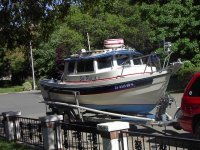Hello Everyone.
When I purchased our TomCat, I had planned to keep it at the marina. However this bad economy scuttled that plan. But I needed to do something to cover the boat, so I rigged a sort of lean-to out of tarp to provide shelter. That turned out to be less than ideal.
I figured with winter coming, I better come up with a better solution. So, I contacted one of those metal building manufacturers to inquire about a carport like structure - with open ends, closed metal sides, and long/tall enough for the TomCat. They gave me a quote of several thousand dollars, installed.
Well, this economy is still working against me, so I am looking for cost effective alternatives, but yet something sturdy that will last at least until the economy picks up again (which could be a long while, unfortunately).
For starters, let me point out I have lots of space, and no covenants or restrictions to deal with. My plan is to erect the shelter across a section of our road which accommodates both coming and going without ever backing up the boat.
We get hardly any snow here, so that is not a factor. But we do get a lot of rain (thunderstorms), and 10-15MPH winds are not uncommon. During Isabel, well got gusts in the 50-60MPH range, but that is extremely rare. Besides, if another Isabel were coming, we would take the boat inland.
In searching for alternatives that I could do myself (or with help), I started looking for ways to build a frame out of steel pipe. This would essentially be a big long box that that I would stretch canvas on (top and sides) to protect the boat.
Anyone ever seen or done something like this?
I stumbled across a company that sells about every pipe fitting you could imagine to pull this off, but they are in India. I prefer to buy American, especially in this troubled times.
Has anyone here seen fittings like these available from a US company?
Is my plan totally crazy?
Any suggestions?
---
mike
When I purchased our TomCat, I had planned to keep it at the marina. However this bad economy scuttled that plan. But I needed to do something to cover the boat, so I rigged a sort of lean-to out of tarp to provide shelter. That turned out to be less than ideal.
I figured with winter coming, I better come up with a better solution. So, I contacted one of those metal building manufacturers to inquire about a carport like structure - with open ends, closed metal sides, and long/tall enough for the TomCat. They gave me a quote of several thousand dollars, installed.
Well, this economy is still working against me, so I am looking for cost effective alternatives, but yet something sturdy that will last at least until the economy picks up again (which could be a long while, unfortunately).
For starters, let me point out I have lots of space, and no covenants or restrictions to deal with. My plan is to erect the shelter across a section of our road which accommodates both coming and going without ever backing up the boat.
We get hardly any snow here, so that is not a factor. But we do get a lot of rain (thunderstorms), and 10-15MPH winds are not uncommon. During Isabel, well got gusts in the 50-60MPH range, but that is extremely rare. Besides, if another Isabel were coming, we would take the boat inland.
In searching for alternatives that I could do myself (or with help), I started looking for ways to build a frame out of steel pipe. This would essentially be a big long box that that I would stretch canvas on (top and sides) to protect the boat.
Anyone ever seen or done something like this?
I stumbled across a company that sells about every pipe fitting you could imagine to pull this off, but they are in India. I prefer to buy American, especially in this troubled times.
Has anyone here seen fittings like these available from a US company?
Is my plan totally crazy?
Any suggestions?
---
mike



